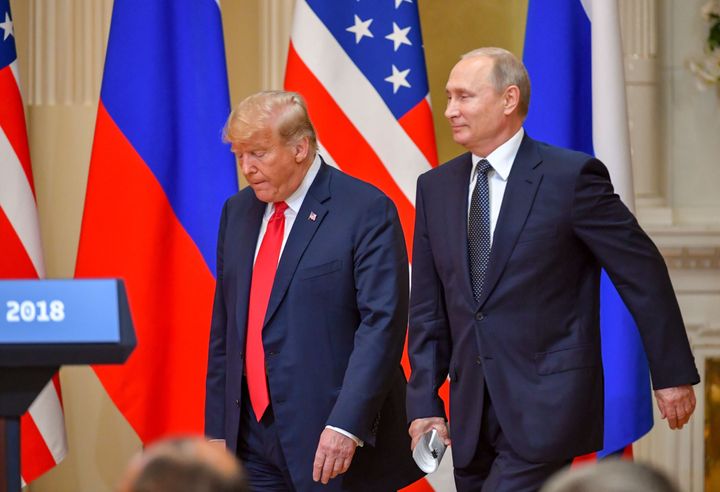WASHINGTON — As former President Donald Trump works to rehabilitate his image on Ukraine by hammering his successor on Russian oil imports, he is hamstrung by his own record on the issue: an increase of 39% of petroleum products from that country over his four years.
“We should not be buying Russian energy,” Trump said recently at the Conservative Political Action Conference in Florida, part of an extended effort to rewrite his Vladimir Putin-friendly presidency into something more attuned to the current sentiment about the Russian dictator. “No president was ever as tough on Russia as I was.”
Trump, though, has not explained why Russian oil imports increased from 142.0 million barrels in 2017, his first year in office, to 197.7 million barrels in 2020 — an increase of 39%.
In contrast, Russian oil went from 205.5 million barrels in 2009, predecessor Barack Obama’s first year, to 161.3 million barrels in 2016, his eighth and final year in office — a decrease of 22%.
Trump’s staff did not respond to HuffPost queries about the matter.
In reality, the imports of crude oil and other petroleum products from Russia into the United States have never accounted for more than a small percentage of this country’s demand. Moreover, purchase decisions are made by individual traders and refinery operators seeking the cheapest source at any given moment, not by the federal government.
The decrease in Russian oil during Obama’s administration coincided with an increase of cheaper U.S. oil thanks to a boom in fracking in shale deposits, according to oil industry analysts. This continued two years into Trump’s years before Russian imports started increasing again as OPEC producers sought to build markets in India and other developing nations, making Russian oil somewhat less expensive in comparison.

Still, the comments by Trump and other Republicans suggest that the U.S. should have actively cut off Russia from the American market some time ago. That did not happen until this week, when President Joe Biden signed an executive order banning such imports on Monday.
Trump’s recent criticism of Russia’s invasion marks a radical departure from his decades of praise for the country and its longtime ruler. In a 2007 letter to Putin, Trump told him he was “a big fan” of his. Five years later — after Putin had already invaded Chechnya and Georgia ― Trump posted on Twitter: “Do you think Putin will be going to The Miss Universe Pageant in November in Moscow ― if so, will be become my new best friend?”
For many years — including during his run for president in 2015 and 2016 — Trump sought a deal to build a condo tower in Moscow. Also in 2016, when asked why he supported a “killer” like Putin, Trump responded that the United States had also killed people. That same year, he openly asked for Russian help in the November election, and then used that help on a daily basis during the campaign’s final month.
Once in office, Trump continued to praise Putin, as well as other authoritarian rulers around the globe, saying he was proud to get along with them. According to his onetime national security adviser John Bolton, Trump tried continually to end sanctions on Russia and prominent Russians, but met resistance from Bolton and others in his administration.
“Putin saw Trump doing a lot of his work for him,” Bolton told Julie Mason’s XM radio show Wednesday morning. “He thought maybe in a second term, Trump would make good on his desire to get out of NATO and that would ease Putin’s path just a bit more.”
Fiona Hill, a Russia expert on the National Security Council during Trump’s years, said while it was true that the U.S. government imposed new sanctions and took other steps against Russia during his term, it was done in spite of Trump, not because of him. “The tough steps were taken by his administration, true, and he didn’t block,” she said. “But that’s about it.”
In 2019, Trump tried to persuade the other large, industrialized democracies in the G-7 to readmit Russia, which had been expelled because of its invasion and annexation of Ukraine’s Crimean peninsula. He defended that annexation because Russia had subsequently built a base there for its “large and powerful submarines.”
Also that year, Trump tried to extort Ukraine’s new president into announcing an investigation into Joe Biden, then the Democrat he feared most as a 2020 challenger. He held $391 million in congressionally approved military aid hostage — thereby helping Putin’s continued efforts to weaken Ukraine. That president, Volodomyr Zelenskyy, is now hailed around the world for his leadership as his country fights Putin’s current invasion.
Trump’s praise for Putin continued even as the Russian dictator began that second invasion of Ukraine last month. “I said, this is genius. Putin declares a big portion of the Ukraine — of Ukraine — Putin declares it as independent,” he told radio hosts Clay Travis and Buck Sexton. “Oh, that’s wonderful. So Putin is now saying it’s independent — a large section of Ukraine. I said, how smart is that? And he’s going to go in and be a peacekeeper. That’s the strongest peace force. We could use that on our southern border.”
Days later, at CPAC, Trump still did not criticize Putin by name, but had stopped praising the invasion. “This is an assault on humanity. So sad,” he said instead.
After Trump’s Ukraine extortion scheme became public thanks to a whistleblower, he was eventually impeached for it in early 2020, but was allowed to remain in office by Senate Republicans. He was impeached a second time in his final days in office for trying to overthrow the republic by inciting a riot to block the certification of his election loss.

